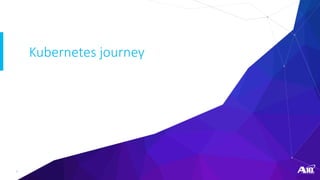Kubernetes Journey of a Large FinTech
This document summarizes a large fintech company in the Philippines' journey to Kubernetes. It faced challenges of legacy systems, static vs dynamic infrastructure, on-prem vs cloud, and security. It adopted a microservices architecture running on Kubernetes with Docker containers. It started with multiple small clusters but consolidated to a single large cluster with namespace isolation for improved cost and manageability. Automations were implemented for operations. Monitoring and logging were set up with ELK and Prometheus/Grafana. A10 was selected for traffic management and security between services. The final deployment provides north-south load balancing and security and east-west traffic security and visibility between microservices.



















Recommended




























































More Related Content
What's hot (20)








































Similar to Kubernetes Journey of a Large FinTech (20)








































More from Akshay Mathur (19)






































Recently uploaded (20)




































Kubernetes Journey of a Large FinTech
- 1. Reliable Security Always™ K8s Journey of a Large FinTech of Philippines
- 3. 3 Who is biggest Influencer? Users They demand a lot! And They need it yesterday!
- 4. 4 It’s not the strongest of the species that SURVIVE nor the most intelligent but the one MOST RESPONSIVE TO CHANGE. “ Charles Darwin (1809-1882)
- 5. 5 APP/IT TEAMS NEED Speed Roll-out Of Revenue- Generating Services Team Agility Self-Service BUSINESS NEEDS Data Security & Privacy Protection For Customers Prevent External Attacks & Access Control Between Distributed Microservices Ease-of- Operations & Improved Team Efficiency Ensure Excellent & Consistent User Experience
- 6. 6 Challenges of running at Scale • Dealing with Legacy (Technical Debt) ◦ Rewrite the application with microservices architecture • Static vs Dynamic Infrastructure ◦ Select dynamic Infrastructure with K8s • On-prem vs Cloud ◦ Select cloud but keep portable • Security ◦ Implement high security because the application deals with monitory transactions and other sensitive information
- 8. 8 Dealing with various stakeholders • CISO office • Developers • Project Managers • Network Admins • Operations Team • Partners and Vendors
- 9. 9 Software Architecture • Every module as microservice • Clear separation of stateless and stateful microservices • Microservices have REST APIs with JSON data exchange • All microservices identified by KubeDNS FQDN • Strict access control of data exchange between microservices • No use of cloud specific features to ensure portability
- 10. 10 Deployment Architecture • Microservices are deployed in Docker containers • Containers are managed by Kubernetes • Each group of services is deployed in separate namespace ◦ Started with multiple small clusters and ended into single large cluster ◦ A few services are still out of K8s • Services of different group sending traffic via Gateway
- 11. 11 Cluster Design: Multiple small clusters • Security and compliance require monitoring traffic between microservices • In absence of policy enforcement, company isolated clusters ◦ Small machines are used • Pro: Each Team had its own area • Con: Cost of infrastructure and management was very high Kubernetes Node Kubernetes Node Kubernetes Node Kubernetes Node
- 12. 12 Cluster Design: Single large cluster with namespace isolation • Separated microservices via namespaces ◦ Large machines are used • Controlled traffic flow via application gateway • Pro: Optimized cost and manageability • Pro: Some E/W traffic info from app-gw • Con: Load on app-gw and NW • Con: Slow response Kubernetes Node Kubernetes Node Kubernetes NodeKubernetes Node
- 13. 13 Operations Automations Also helps in dealing with failure • Complete infrastructure remains as code in SCM system (GIT) • Entire cluster is deployed/destroyed via CI/CD tools (Jenkins and Ansible) • Support system tools (controllers, log collectors etc.) follow same principles • K8s rolling update along with readiness and liveness probe ◦ Entire application is redeployed in UAT on every code commit by any developer • Sometimes rolling update happen multiple times in a min
- 14. 14 Monitoring and Log Collection • Huge ELK deployment in K8s (separate cluster) collecting logs for every component/service • Prometheus and Grafana for monitoring container infrastructure • A10 Harmony Controller (separate cluster) for traffic observability
- 15. 15 Selection of Traffic Management Solution vs Kubernetes NodeKubernetes Node Sidecar Proxy Deployment Hub-Spoke Proxy Deployment Resource intensive Expensive TCO Low overhead Lower TCO
- 16. 16 Application Security and Traffic Management • North-South Traffic ◦ AKAMAI cloud is taking care of SSL offload and WAF ◦ Additional security policies are implemented by A10 Lightning ADC ◦ A10 Lightning ADC takes care of traffic distribution between microservices • East-West Traffic ◦ A10 Lightning ADC works as transparent service proxy ◦ Access control, Mutual TLS and transparent encryption by Lightning ADC eliminated requirement of external GW • Harmony Controller provides observability on both N-S and E-W traffic
- 17. A10 Secure Service Mesh This Highly-Scalable Solution Provides the Following Capabilities o North-south traffic load balancing, service discovery and application security o East-west traffic security and policy enforcement between microservices o Centralised application traffic visibility and control
- 18. 18 Final Deployment Diagram POD Service-1 POD POD Service-2 Service-3 POD Service-1 POD POD Service-2 Service-3 Node 1 POD Service-1 POD POD Service-2 Service-3 Kubernetes Connector Harmony Controller Node 2 Node N
- 19. Thank You Reliable Security Always™
Editor's Notes
- #5: Users are demanding Users needs always evolving Quote To succeed in FINTECH, your business needs…
- #6: Let’s take a look at some of the struggles and business challenges IT experts and CISO’s are dealing with on a daily basis: The average enterprise is running applications in at least 5 clouds. That represents quite a complex application networking and security environment. According to a recent survey by 451 Research, 71% of enterprises are either using or evaluating container orchestration options like Kubernetes and Docker. On the other hand and according to a study by Ponemon, 65% of all security issues are due to human error and inadequate in-house security expertise. The Ponemon Institute published a study recently whereas 79% of enterprises lack a comprehensive DDoS attack and mitigation strategy.


